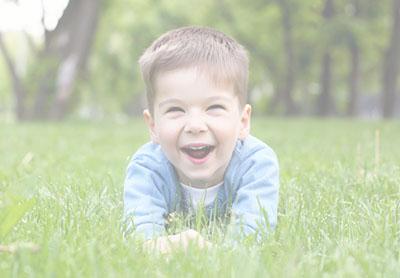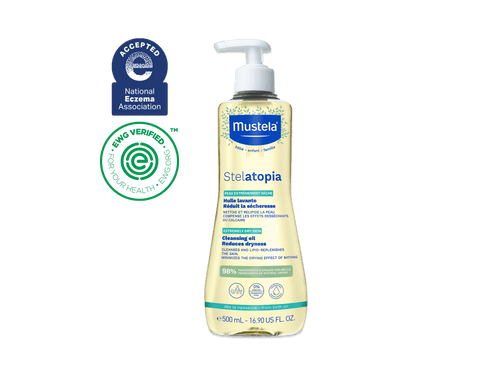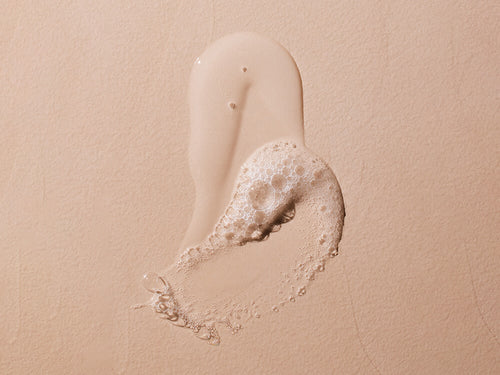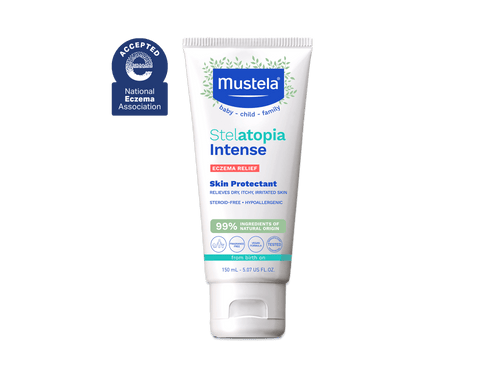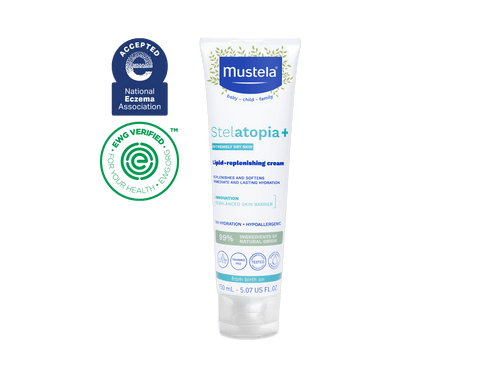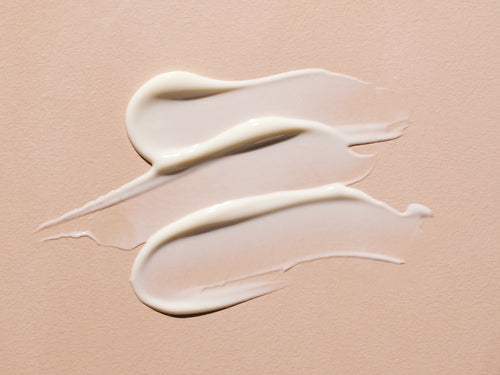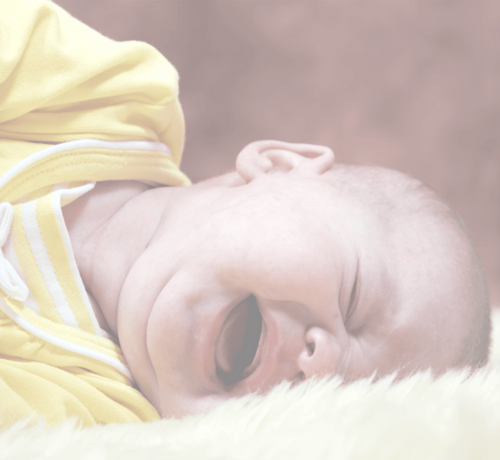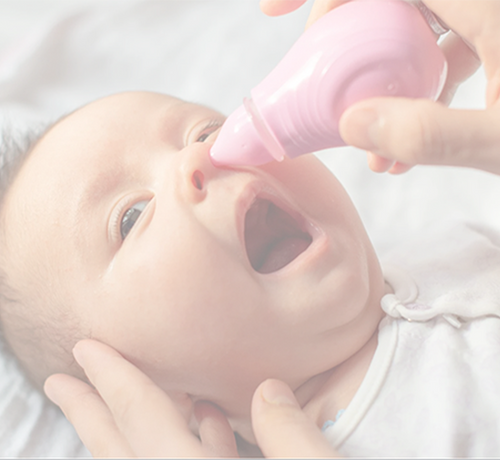What Is Eczema?
Eczema, or atopic dermatitis, is a common skin problem that can affect newborns, babies, children, and adults. Symptoms include dry, red, itchy skin that can flare up in the presence of a number of allergens and environmental factors.
In babies, eczema flare-ups can first appear between birth and three months. With the right treatment, those flare-ups will eventually disappear, but the potential for future flare-ups will always remain. For children, then, prevention is the key to keeping these uncomfortable dry, itchy patches at bay.
But what exactly is eczema? What causes flare-ups to occur? And what is the difference between baby, child, and adult eczema? The experts at Mustela will answer all those questions and give you seven steps to treat and prevent your child’s eczema flare-ups.
Table Of Contents
- What Is Childhood Eczema?
- What Causes Eczema Flare-Ups?
- Is There A Cure For Childhood Eczema?
- The Difference Between Baby And Child Eczema
- The Difference Between Child And Adult Eczema
- Treatment And Prevention Of Child Eczema Flare-Ups
- Relieving Itchy, Painful Eczema
- When To Visit A Doctor
- Frequently Asked Questions

What Is Childhood Eczema?
Eczema is a genetic condition that causes the hydrolipidic layer that covers your child’s skin to become thin in certain spots and eventually break down. This protective layer does two things:
- It prevents moisture from evaporating.
- It protects skin from external irritation.
So when a small hole in the hydrolipidic layer develops, it allows moisture to escape and allergens to come in contact with the deeper layers of your child’s skin. When that happens, a flare-up is likely to occur, causing your child’s skin to become red, swollen, and itchy.
What Causes Eczema Flare-Ups?
The main causes of child eczema flare-ups include:
- Dry skin
- Environmental allergies
- High temperature
- Pollution
- Pet dander
- Tight or abrasive clothing
- Too much bathing

Even though there are many factors that can lead to an eczema flare-up, treatment is simple and effective, regardless of what caused the reaction in the first place. Before we discuss the seven ways to treat and prevent child eczema flare-ups, let’s find out a bit more about the condition itself.
Is There A Cure For Childhood Eczema?
Eczema is a genetic condition, much like dust or food allergies. That means there is no cure. You can treat the symptoms (red, itchy patches), but the condition will never go away completely. As your child gets older, though, their skin will mature and their hydrolipidic layer will thicken, thus reducing the likelihood that a flare-up will occur.
The Difference Between Baby And Child Eczema
The primary difference between baby eczema and child eczema is where the flare-up occurs. The flare-up itself will look roughly the same — red, swollen, irritated skin — regardless of age, but the location of the flare-up will likely change as your child grows.
Newborn To 6 Months
- Face
- Cheeks
- Forehead
- Scalp and head
6-12 Months
- Elbows
- Knees
- Shins
- Forearms
12 Months To 5 Years
- Front of the elbow
- Back of the knee
- Wrists
- Ankles
- Around the mouth
- Eyelids
5 Years And Older
For older children, flare-ups are often restricted to the hands or the folds of the elbows and knees.
The Difference Between Child And Adult Eczema
There is very little difference between child eczema and adult eczema. The main difference is the frequency with which flare-ups occur. As your child grows older, their skin becomes thicker and less sensitive. And with the right ongoing treatment, the occurrence of eczema flare-ups can be reduced.
So now that you know a bit about eczema, what causes flare-ups, and the difference between baby, child, and adult eczema, let’s turn our attention to treatment and prevention.
Treatment And Prevention Of Child Eczema Flare-Ups
1) Establish A Daily Skincare Routine

As soon as you see signs of a flare-up or suspect that your child might have eczema, the best thing you can do is start a daily skincare routine that includes emollients like Mustela’s Stelatopia Emollient Cream, Stelatopia Emollient Balm, or Stelatopia Intense Eczema Relief. These products provide four essential benefits:
- They reinforce the protective moisture barrier on your child’s skin.
- They add moisture to your child’s skin.
- They prevent moisture from evaporating.
- They soothe the itchiness and discomfort caused by eczema flare-ups.
All of Mustela’s eczema-prone skincare products are safe for children, newborns, and adults.
By keeping your little one’s skin hydrated and nourished, you’ll decrease the likelihood of eczema flare-ups, especially during those pesky colder months when the air tends to be drier.
2) Inspect Your Child’s Environment For Triggers
Common environmental triggers include dust, rough fabrics, and even high temperatures that can irritate your child’s skin, leading to a flare-up. To prevent these itchy, red breakouts, inspect your child’s environment, and remove or prevent contact with:
- Tight or rough clothing
- Hot water
- Chlorinated water
- Pet dander
- Dust
- Harsh soaps
- Dry air
- High temperatures
Granted, it’s not always possible to prevent all triggers from coming into contact with your child’s skin. But as long as you keep sensitive skin covered with an emollient, eczema flare-ups will be less likely to occur.
3) Prevent Eczema Flare-Ups Caused By Bath Time

To prevent eczema flare-ups caused by dry skin after a bath, follow these three simple steps:
- Use only lukewarm water.
- Add Mustela’s Stelatopia Cleansing Oil to the water.
- Wash your child with Mustela’s Stelatopia Cleansing Gel.
For further flare-up protection, pat your child’s skin dry (instead of rubbing) with a soft towel and then apply an emollient cream immediately after bath time.
4) Talk To A Doctor About Food Allergies
If you ever notice that your child’s skin is red and irritated after eating certain foods — particularly on their face or mouth — then their eczema may be a reaction to a food allergy. If it’s a mild reaction, we recommend consulting your child’s dermatologist and informing them of the food your child consumed prior to their reaction.
But remember that baby skin is sensitive, so it’s possible that if you find yourself rubbing away food mess from the corner of your little one’s mouth during mealtime, the rubbing sensation may be irritating their tender skin.
Ask your child’s doctor if you can apply a thin layer of emollient cream to the area where food often is stuck and must be rubbed away. This could mitigate the increased irritation.
It’s rare that your child’s eczema flare-ups are caused by food allergies, but it is possible. If you have removed all potential environmental triggers and are applying a daily emollient but the flare-up refuses to go away, it’s time to consult your doctor or pediatrician. They can test your child for food allergies (and other allergies) and help identify what might be irritating your child’s sensitive skin.
5) Protect Sensitive Skin With Long Pants And Long Sleeves
When your child wants to go outside to play, it’s important to protect their skin with long pants and long sleeves. This will keep environmental triggers like dirt, dust, and grass from irritating your little one’s skin and causing a flare-up.
Be sure to apply an emollient product before dressing your child, and if it’s warm, choose soft, breathable clothes to prevent excessive sweating.
This same rule applies to their pajamas. When your child is bundled up in their blankets at night, they can easily become overheated if they go to sleep wearing tight pajamas. Sweating and overheating are major causes of eczema flare-ups, so dress your little one in loose, cotton pajamas so their skin can breathe.
We recommend our Stelatopia Skin Soothing Pajamas. Designed for babies and toddlers with eczema-prone skin, these 100% cotton pajamas deliver skin-soothing moisture throughout the night!
6) Apply A Sunscreen Before Your Child Goes Outside
To protect your child’s skin from becoming irritated by the sun, always apply sunscreen before they go outside. Even better yet, we recommend following the below steps:
- Apply an emollient first (about a half-an-hour before your child goes outside, if possible).
- Cover your child’s skin with a high-SPF sunscreen like Mustela’s SPF 50 Mineral Sunscreen Lotion. Be sure to reapply often if your child will be outside for more than 2 hours.
- Finish by dressing your child in long pants, long sleeves, and a wide-brimmed hat.
When your child comes back inside, apply a soothing product like Mustela’s After Sun Lotion to counteract the dehydrating effects of the sun.
7) Teach Your Child To Avoid Or Cope With Stressful Situations
Stress can cause flare-ups just like environmental triggers can, so you should teach your child to avoid or cope with stressful situations whenever possible. When major changes in your child’s life occur—first time at daycare, starting preschool or kindergarten, a move to a different town—be sure to reassure your child that everything is going to be okay.
If necessary, teach your child some coping techniques such as deep breathing or visualization. These will help your little one deal with the inevitable stresses that they will encounter throughout life.
8) Consider Ditching Chemical Products
Sometimes we aren’t even aware of the sensitivities our skin has to certain chemical compounds, or how many of them exist in the products we use daily. Without understanding where potential irritant exposure comes from, it’s difficult to address your child’s eczema flare-ups.
A common source of skin irritants can actually be the way we wash our clothes. Laundry detergents are full of fragrance, colorful dyes, and other artificial additives that can unintentionally leave skin feeling stripped, dry, chapped, or irritated.
If you find that your child’s skin is particularly irritated in the areas where their clothing tends to rub against it — at the collar, their wrists and ankles, at the waistband, or across their back — it may be time to opt for a dye-free, fragrance-free laundry soap and fabric softener.
Removing these irritants should help soothe your child’s delicate skin. If you typically clothesline your clothes, we recommend using an electric dryer in your routine as often as possible. This helps prevent dust or dirt from accumulating on your child’s clothes while they dry and makes the clothes softer than they would be otherwise.
If your child’s skin is sensitive to tags, consider taking those out as well.
You can expand this harmful-chemical-ban to other products in your household, too. Things like baby wipes, diapers, baby shampoos, moisturizers, and other skincare products often include fragrance and alcohol, which are well-known causes of skin irritation. Eliminating them from your child’s routine can help avoid eczema issues.
Look for products that are free of fragrance, alcohol, and other irritants, and instead prioritize ingredients that will soothe your child’s skin. Some great options include products with oatmeal, aloe vera, shea butter, honey, or other moisturizing, soothing ingredients.
Our organic products are ideal for sensitive and eczema-prone skin and include these and other nourishing ingredients!
Relieving Itchy, Painful Eczema
While your child is on a journey to address their eczema flare-ups, we know there may be moments when their skin is uncomfortable and unmanageable in the meantime. All they want is some relief!
Here are some ideas for how to soothe and nourish your child’s skin at home when their eczema is making them uncomfortable.
Gently Apply A Cold Compress
For those swollen, red patches of skin that feel like they’re burning up, we recommend applying a damp, cool towel to the area.
Make sure you squeeze the towel or cloth until it no longer drips water. If your child can handle things on the icier side, soak the rag in the coldest water possible.
Leave the compress on the affected area for 30 seconds on and off until the swelling begins to subside.
Pinch The Area
This may sound crazy, but instead of scratching the area that itches, giving it a small pinch can help relieve some of the itchy irritation.
Just warn your child beforehand that you’ll do it so they’re not surprised!
Distract Your Child
It can be hard to resist the urge to scratch those irritated, itchy flare-ups, but it’s so important to prevent your child from doing so! Leaving their skin alone gives it the best chance to recover and reduce inflammation.
But we all know it’s not as simple as encouraging them to stop scratching (oftentimes, this can make things worse because it keeps their mind on the itchiness!).
Instead, take their mind off of it by doing one of the things they love the most—playing! By motivating them to exert their energy, you can help them forget about their itchy skin, at least for a little while.
You could:
- Read a story together
- Play hide and seek
- Make some snacks or cookies together
- Play pretend with some of their toys
No one knows your little one like you do. Picking their favorite pastimes will make ignoring their itchy skin that much easier.
Give Your Little One An Oatmeal Bath
Oatmeal baths aren’t reserved for folk tales about soothing chickenpox — they really work!
Colloidal oatmeal is a naturally soothing, emollient product that adds moisture to the skin and soothes itchy irritation. It can provide immense relief to your child during those nights when their inflamed skin is getting the best of them.
To use colloidal oatmeal, add it underneath a running faucet or to warm water. Allow your child to relax and play in the oatmeal bath for at least 15 minutes so their skin has time to be soothed and absorb the oatmeal’s beneficial properties.
Colloidal oatmeal is safe to apply to the face as well, though you should be careful not to let the oatmeal enter your child’s mouth or eyes. You can crank up the fun by hopping in the bath with them, as it’s great for your skin, too!
Once they exit the bath, your child may be a little slippery. Gently pat their skin just dry enough that they still feel damp without dripping. Then, apply your favorite emollient cream to lock in their skin’s new nourished, soothed state.
When To Visit A Doctor

There’s often no need to visit a doctor or pediatrician at the first sign of an eczema flare-up. In most cases, applying an emollient cream or balm multiple times throughout the day should be enough to treat the flare-up. It’s also important to inspect your child’s environment to see if any triggers are present.
Does a new piece of clothing rub the wrong way or is it too rough? Is it time to give your child’s room a thorough cleaning? Identifying and removing these triggers can help decrease the duration of the flare-up.
If the eczema flare-up is still present after seven days despite using an emollient product, or if you notice a yellow or light-brown crust or blisters on top of the flare-up, call your doctor as soon as possible.
This could be a sign that your child has a bacterial infection. In these cases, your doctor may prescribe an antihistamine or an antibiotic. These medications will reduce the swelling, irritation, and itchiness that are causing your child so much discomfort. With the flare-up gone, your child will feel better, sleep better, and be happier overall.
Help Your Child Keep Their Chin Up
The itchy swelling that comes with childhood eczema can be tough. And not every person is the same, so it may take some time to figure out the perfect combination of products and treatments to keep your little one’s skin feeling nourished, moisturized, and soothed.
With time, your child’s eczema will likely feel like a thing of the past. It’s all about progress! Of course, if their condition persists, the best person to consult is their pediatrician or dermatologist.
From all of us at Mustela, we wish for happy, healthy skin in your child’s future!
Frequently Asked Questions
1) Is Baby Eczema Serious?
Baby eczema can be mild, moderate, or severe. The severity of your child's symptoms will determine how bothersome the eczema is and how much it affects their quality of life.
While it’s not usually a serious condition, severe eczema can be uncomfortable and may interfere with a child’s sleep. Therefore, discussing your concerns with your doctor and working together to develop a treatment plan for your baby is always best.
2) Does Breast Milk Help Eczema?
Breast milk is amazing!
For generations, moms have used their milk to treat various skin problems. However, the scientific community has recently been studying the powers of breast milk a bit more closely, and they’ve discovered some promising results using breast milk on eczema.
In fact, preliminary studies suggest that breast milk may help improve eczema symptoms. If you want to try this natural remedy, apply some of your milk to a cotton ball. Then, apply it to the eczema patches on your baby’s skin.
3) What Foods Should Babies With Eczema Avoid?
Unfortunately, eczema and food allergies often go hand-in-hand. So, if your baby has eczema that's hard to treat, there's a good chance that something in their diet is making their symptoms worse.
Keep a food journal to determine if your baby's eczema is food-related. For two weeks, write down everything that your baby eats. Then, take note of any flare-ups you notice. If a pattern emerges, talk to your child's doctor about having them tested by an allergist.
Some foods commonly cause problems for babies with eczema. These include cow's milk, eggs, peanuts, soy, wheat, fish, and shellfish.
4) How Long Do Eczema Flare-Ups Last In Babies?
Eczema flare-ups typically last for at least a few weeks. The length of time depends on the severity of your child's symptoms and what treatment options you try. Left untreated, these flares can last for months or even longer.
But, if you can start moisturizing their skin right away with products designed for eczema-prone skin, you can help them heal more quickly. The Mustela Eczema Bath Time Set is an excellent place to start.
5) How Often Should I Bathe My Baby If They Have Eczema?
The National Eczema Association recommends taking a short bath every day to help minimize eczema symptoms. But, as mentioned earlier, hot water and extended soaks can worsen this condition.
Make sure to keep your baby’s baths lukewarm and watch the clock while bathing them. Try to keep their time in the tub under 10 minutes.
Afterward, apply a quality moisturizer, such as our Stelatopia Emollient Cream, within three minutes of getting out. This timeframe will help prevent further drying.


